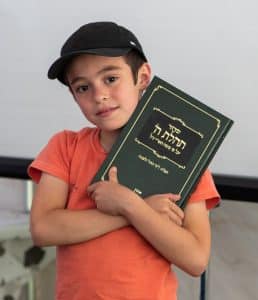By Mrs. Chanah Rose
 The Frierdiker Rebbe once said1 ספר השיחות לה”ק תש”ד-קכד (“התפילה והעבוד”, הרב יקותיאל גרין, דף 156): “A foundation of Chassidus is Tefilla. Just like in learning, we need to learn how to learn, so too with Tefilla – we have to learn how to Daven.”
The Frierdiker Rebbe once said1 ספר השיחות לה”ק תש”ד-קכד (“התפילה והעבוד”, הרב יקותיאל גרין, דף 156): “A foundation of Chassidus is Tefilla. Just like in learning, we need to learn how to learn, so too with Tefilla – we have to learn how to Daven.”
From this brief quote we learn several monumental ideas. One is about Chinuch in general, that the emphasis needs to be on how to learn, rather than the subject matter itself – something that rings so true in our current era when factual knowledge, translations, and resources for learning are as near and accessible as the phone in our pockets. When we give students skills for learning, we have given them a gift that no technology can give – the ability to access learning, deeply and authentically, on their own.
Zooming in, we learn what our approach needs to be to teaching Tefilla. Firstly, that Tefilla is not just one of many things that we try to give over to the next generation. In a Chassidishe Chinuch, it is fundamental, and needs to be a primary goal and focus for parents and teachers. Secondly – and to me this was a bombshell – is that the emphasis in Chinuch on how over what, applies even more so to Tefilla.
From a young age, we teach our children what we need to Daven and why, the translation and pirushim of the Tefillos, and the necessary halachos and minhagim. All this is crucial. But are we also teaching them the how? More fundamentally, are we ourselves focused on the how – not just the mechanics of the Davening, but how to access this incredible tool for connecting to Hashem and our Neshamos?
Through teaching Tefilla as a subject in various grades and settings, I was fortunate to embark on a journey of exploring the deeper meaning of Tefilla, through the lens of Chassidus. There are a number of mashalim that have helped me and my students better understand various aspects of Tefilla, and both for the purpose of Chinuch as well as for ourselves, I’d like to share these with you.
***
 Avoda – Polishing Diamonds
Avoda – Polishing Diamonds
Avoda literally means hard work, but there are some kinds of work that are as beautiful as they are challenging. In Chassidus, Tefilla is almost synonymous with the word Avoda; why?
This is because the work that we are doing during Tefilla is the demanding and thrilling labor of polishing the diamond within each of us, by revealing and uncovering our Neshama.
Polishing diamonds is a beautiful imagery that can be used at all ages to depict what transpires during Tefilla. Precious lessons gleaned from delving deeper into a Tefilla can be graphically depicted as diamonds we uncovered. The theme for my fourth grade Peirush Tefilla class was that “Tefilla is My Time to Shine,”2 See also Likkutei Torah on Parshas Ki Seitzei, where the Alter Rebbe describes the time of Tefilla as a time of battle, and at war, everything “shines” because our kochos are brought out to the utmost. (Many thanks to Rabbi Hirsch Rabiski, shaliach in Toronto, CA, for making this connection.) and a journal was assigned wherein students wrote about what they “uncovered” through the deeper meaning of each Tefilla.
This is because by Davening, we are giving our Neshama a voice. We are providing her with the words that were really hers all along. And kavana during Davening – the true Avodas HaTefilla – means that while the Neshama speaks, we truly listen.
We listen to the Neshama’s true priorities in life. We listen to her praising our Creator and become inspired. We embark on a journey of coming closer to the Aibershter, and the rest of us, Nefesh Habehamis included, comes along for the ride.
And so, every time we Daven, our Neshama shines a little brighter. Our entire being is more receptive to her light. We have discovered and uncovered our inner diamond, through Avodas HaTefilla, a bit more each day.3See the Tanya’s explanation in פרק י”ב of the roshem, the lasting impression, that Tefilla leaves on a person for the remainder of the day.
The Navi4 מלאכי ג:יב describes Bnai Yisrael as an Eretz Chaifetz, a desirable land, and Hayom Yom5 היום יום ב’ אלול dwells on this concept by describing the great riches and resources within every single Jew, that depend only on the diligence of the one digging to uncover them. Similarly, many are familiar with the story of the Rebbe answering an old woman on the Sunday dollars line, that the reason the Rebbe does not get tired while standing for hours giving dollars to Yidden, is that a person does not tire of counting diamonds. We are treasures. The Neshama is truly a gem that each of us holds.
This is a great paradigm for framing the Avoda of Tefilla as truly the work of accessing our true self. Should this seem a self-centered shift away from the focus on talking to Hashem during Tefilla, I didn’t make it up – the word Tefilla itself comes from the reflexive verb l’hispallel. When we are davening, we are focused on Hashem, it’s true, but thereby we focus inward. As children, we learn that when we Daven we are talking to Hashem, but when we delve deeper we learn that at the very same time, when we Daven, we are talking to ourselves.
This opens the door to all kinds of learning and discussion of what, indeed, every word and section of Tefilla has to teach me. This leads us to ask ourselves what hachlatos tovos or paradigm shifts (hanachos) we are moved to as we truly focus on our Davening. And if “Tefilla is My Time to Shine” seems like a lofty theme for young children, you can just flip through the journal entries of some real life 4th graders (with their permission, of course), or sit in on their year-end farbrengen where they shared their Tefilla inspiration (luckily, those farbrengens may be recorded somewhere – this was in the Shluchim Online School!).
Which brings us to the next Mashal:
Read the next article Teaching Tefillah Part 2 -“The Ladder of Tefillah:”
- 1ספר השיחות לה”ק תש”ד-קכד (“התפילה והעבוד”, הרב יקותיאל גרין, דף 156)
- 2See also Likkutei Torah on Parshas Ki Seitzei, where the Alter Rebbe describes the time of Tefilla as a time of battle, and at war, everything “shines” because our kochos are brought out to the utmost. (Many thanks to Rabbi Hirsch Rabiski, shaliach in Toronto, CA, for making this connection.)
- 3See the Tanya’s explanation in פרק י”ב of the roshem, the lasting impression, that Tefilla leaves on a person for the remainder of the day.
- 4מלאכי ג:יב
- 5היום יום ב’ אלול




